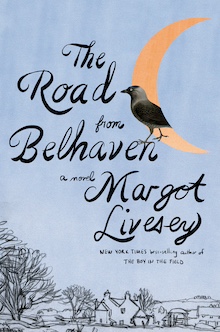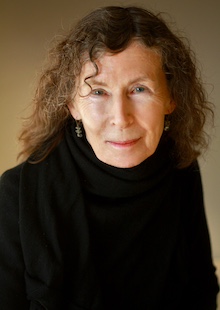
In The Road from Belhaven (Knopf) by Margot Livesey one gets lost in the quiet beauty of the 19th century Scottish countryside. Lizzie Craig, raised by her grandparents, knows that she has the gift of second sight from the moment that her first glimpse of the future comes into fruition. A blessing and a curse, the images that she sees are selective about what they show her and she is left reeling to make sense of some of them. When she gives birth to a daughter of her own Lizzie must start to make decisions for both of them. No less prepared for things that are to come than her family members who do not share her gift, Lizzie finds herself following the boy that she fell in love with on the long road from her childhood home to the big city of Glasgow and into an uncertain future. It is when she leaves Belhaven that Lizzie realizes how much of herself she left behind. The Road from Belhaven navigates both multigenerational burdens and gifts in a snapshot of one woman’s struggle to carve out a future for herself and her daughter. Through beautiful prose Livesey explores motherhood, home, familial conflict, self-discovery, and the quest for a place to tether oneself to.
+

Natalie Doris: You mention in the afterword that you wrote The Road from Belhaven while stuck stateside during the pandemic, which means that you were writing about both a historical moment and a place that you were not currently living in. How did you immerse yourself in the world you were writing and what was the experience of vacillating between Belhaven and your present life?
Margot Livesey: I hated not being able to go to Scotland in person during the pandemic but I went there in many other ways – through reading, through memory, through imagination, through conversations with friends and my beloved adopted family. Often at the end of a day it was a shock to find myself still in Boston, making supper.
ND: We all experience some of the pull of homesickness and lure of independence that your heroine Lizzie Craig struggles with when she first leaves Belhaven for Glasgow, and later when she flees to Burntisland. Your own road from home is even longer than Lizzie’s. Can you share a little bit about the experience of connecting with your own home and family that informed your writing of The Road from Belhaven?
ML: After the early deaths of my mother and father, I thought of myself as someone with no living relatives. Then in 2017, I learned through Ancestry.com that I have many relatives. They just all happen to live in Australia. Later that year I flew to Brisbane to meet them, hoping to feel a spark of connection. Most of them seemed like affable strangers but I did feel close to the two oldest members of the family, Gwen and John. They were the ones who told me stories about my great grandmother Lizzie Craig.
ND: When I read the description of your novel and the first page, I thought that Lizzie’s “pictures” existed to drive the narrative forward. I was surprised, and pleased, to find that instead they were an integral part of Lizzie rather than a plot device. The way that you wove second sight into Lizzie’s story called to mind folk stories. What influences did you call on when writing a character with an extraordinary ability who is living what is otherwise an ordinary life?
ML: Lizzie is very, very loosely based on the stories I learned from Gwen and John. I also drew on my childhood reading – particularly the wonderful novels of George MacDonald and various tales of the uncanny. And I consulted a couple of friends who, very occasionally, get glimpses of the future.
ND: I was very interested in the importance of maternal lineage in your novel. Lizzie and Kate lose their own mother, the familial link between them, when they are very young. Lizzie has a complicated relationship with her grandmother, who raised her, and with her own daughter. Even second sight is passed through the women in the family. What inspired you to write these complex relationships between mother and daughter figures?

ML: I have no memories of my mother Eva but family friends told me about her relationship with the supernatural. Eva did not see the future but she did see people who were not visible to most other people. And her patients, in the hospital where she worked as a nurse, complained that her wards were regularly visited by poltergeists. More than twenty years ago these experiences inspired me to write a novel, Eva Moves the Furniture. So when I learned that my great grandmother had second sight I was at once intrigued; perhaps such gifts were passed down from woman to woman.
ND: Lizzie lives at a time when the industrial revolution created many more possibilities for women but she is lucky enough to find a very unusual job.
ML: Yes, she works as a locomotive tracer. This was a stroke of good luck for me and for her. I was reading The Girl’s Own Paper when I came across a wonderful essay describing this job which involved meticulous drawing and tracing of various plans.
ND: The letters that Lizzie exchanges with her sister Kate regarding her pregnancy and her relationship with Louis reveal an intimacy between sisters pulled in two different ways by society. Lizzie’s daughter is born outside of wedlock while Kate’s children are all born after she is married, despite the fact that she also becomes pregnant before she marries Callum. What was the inspiration for these letters and how did you gain access to the social attitudes of the time in order to flesh out the relationship between the sisters?
ML: I blame Jane Austen and her heirs for our widespread belief that the Victorians were terribly respectable. Reading diaries, letters and parish registers of the time gives a quite different impression. Many more people had relationships outside marriage than are described in the pages of Dickens, Trollope and Elliott and these relationships did not invariably lead to tragedy. The shape of women’s lives was often much more complicated.
ND: You visit Scotland a lot in your writing. Has your writing process and the research you have done changed your understanding of Scotland and your own culture?
ML: Although I grew up on the edge of the Scottish Highlands, both the boys’ private school, where my father taught, and the girls’ school, I attended, were very focused on England. I studied no Scottish literature or history or geography. It’s only as an adult that I’ve come to appreciate the culture of my homeland. One reason I like to set novels in Scotland is because I want to understand the country more deeply.
ND: The societal constraints on women are evident throughout the novel. At what point in your writing process do you feel that these themes emerge? Are you aware that you want to explore them when you begin writing or do they emerge later?
ML: My understanding of the deeper questions of a novel often surfaces quite late but I think it’s no accident that I was writing The Road from Belhaven at a time when America is once again seeking to constrain women’s lives. I regret that, in certain respects, the novel is so timely.
ND: What is next for you and your writing?
ML: I am working on a new novel set close to the present which is about the aftermath of a will. I hope the characters will also be caught up in some of Scotland’s more recent history.
+++
Margot Livesey was born and grew up on the edge of the Scottish Highlands. She is the author of a collection of stories and nine other novels, including Eva Moves the Furniture, The Flight of Gemma Hardy, and The Boy in the Field. She has received awards from the NEA, the Guggenheim Foundation and the Radcliffe Institute. She lives in Cambridge, Massachusetts and is on the faculty of the Iowa Writers’ Workshop.
+
Natalie Doris studied creative writing at the University of Arkansas at Little Rock. She is a practicing in-house corporate attorney.